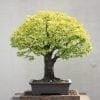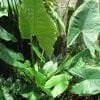The Black Olive species is one of the most beloved types of Bonsai because of its lush leaves and interesting growth pattern. Native to the Florida Keys, Cuba, Puerto Rico and the Bahamas, the trees tend to do best in warm climates and have a very high tolerance for salt, making them good options for those who live by the sea.
| Scientific/Botanical Name | Olea europaea |
| Description | Black Olive tree is non-deciduous: The tree remains evergreen year-round. It is indigenous to the Mediterranean region, and is the source of olives and olive oil. After flowering, the tree produces the olive fruit at the end of summer. |
| Position | The tree needs full summer sun. If grown indoors, place the tree outside during the summer months. Keep the tree cooler in winter, but avoid freezing conditions. |
| Watering | Allow the plant to dry out slightly, and then give it a thorough watering. |
| Feeding | Feed every other week during spring and summer. Bonsai fertilizer is best, yet regular plant food may be used — but only at half strength. No fertilization is necessary in the three months following re-potting. |
| Leaf and Branch Pruning | Prune to shape the tree in the fall. By pinching-out the stems, smaller leaves will be encouraged. |
| Re-potting & Growing Medium | Re-pot the tree after two or three years, and always in the spring. The ball of the roots should be trimmed by about one third. Use soil that allows for free drainage. |
| Wiring | The tree branches are fragile, and it is best to apply wire during periods of dormancy. |
| Notes | The olive tree is an ideal specimen for training as a bonsai, and is amenable to many styles of shaping. |
Growing Conditions
Lighting
Black Olive Bonsai trees flourish in zones that receive plenty of full sun. Even as indoor plants, the trees require a significant amount of sunlight.
Temperature
The trees grow best in zones 10B to 11. Ideally, the Black Olive tree should be kept in temperatures under 64 degrees during winter, but they should never be exposed to temperatures below 40 degrees.
Watering & Feeding
Watering
Black Olive Bonsais should be well-watered and never dry. Close attention must be paid to watering because Bonsai trees are grown in small pots and therefore dry out much more quickly than plants grown in the ground or in larger pots. To water the Black Olive Bonsai, place the pot in a sink filled with two inches of water. Let the water seep into the pot through the drainage holes. You may also mist your Black Olive Bonsai once each week to keep leaves hydrated.
Feeding
The Black Olive tree should be fertilized mid-spring using a pulverized organic formula. A general purpose plant food may be used once every two weeks from spring until autumn.
Pruning
Pruning to Create New Shoots
Black Olive trees do not produce new shoots when a branch is pruned. If you wish to foster new shoots, let them mature into branches before shortening them.
Pruning to Develop Foliage
To develop new leaves, use your fingers to pinch off the first few leaves per branch, leaving green stems behind.
Shaping
Natural Shape vs. Bonsai Shape
Full-grown Black Olive trees are characterized by their pyramidal shape and dense oval crown. In Bonsai form, the trees are prized for their exotic shapes made by zigzagging branches that spiral as they grow. Alternating branchlets are often wired to create a more classic shape with raised tops. Black Olives look particularly attractive when grown in a windswept design.
Wiring For Shape
Always use the thinnest wire possible to secure the branch in the desired position. To keep the wire from loosening, wind the training wire in the same direction of the branch’s bend. Caution must be taken to not wrap the wire too tightly, which will result in scarring. Start the wiring process at the Black Olive’s base so the trunk serves as an anchor. Continue to wire along the branch that will be trained. Repeat the process on all branches that require training, using the trunk as an anchor each time.
Black Olives may scar more easily than other Bonsai species, so carefully watch for signs of cutting when wiring. If you notice cuts in the bark, remove the wire immediately to prevent scarring. The tree can be rewired using more gentle techniques once the old wire is removed.
Repotting
Black Olive Bonsai trees may be repotted once every three to four years. Black Olive roots are highly sensitive compared to other tropical trees, so avoid doing a major pruning all at once. When repotting, gradually reduce the roots but avoid eliminating more than 30 percent of the root ball.
About half of the fine roots should be maintained. Repot during May or June to ensure that the Black Olive can regenerate new roots before cooler weather arrives. Always repot using a fast draining soil that contains a high concentration of sand and lime.
Common Problems
Mold
Black Olives are particularly susceptible to mold problems during wet weather periods in winter and autumn. A mild fungicide may be applied as needed to remedy mold problems.
Pests
The trees may become hosts for ants, aphids and eryphide mites. If pests are a problem, use a gentle insecticide that contains resmethrin, acephate or triforine to eliminate insects without harming the tree. To prevent pests, Black Olive trees may be treated every three months with a non-toxic spray but should never be treated when the soil is dry.


